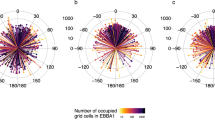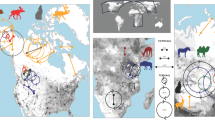Abstract
Many species migrate long distances annually between their breeding and wintering areas1. Although global change affects both ranges, impact assessments have generally focused on breeding ranges and ignored how environmental changes influence migrants across geographical regions and the annual cycle2,3. Using range maps and species distribution models, we quantified the risk of summer and winter range loss and migration distance increase from future climate and land cover changes on long-distance migratory birds of the Holarctic (n = 715). Risk estimates are largely independent of each other and magnitudes vary geographically. If seasonal range losses and increased migration distances are not considered, we strongly underestimate the number of threatened species by 18–49% and the overall magnitude of risk for 17–50% species. Many of the analysed species that face multiple global change risks are not listed by International Union for Conservation of Nature as threatened or near threatened. To neglect seasonal migration in impact assessments could thus seriously misguide species’ conservation.
This is a preview of subscription content, access via your institution
Access options
Access Nature and 54 other Nature Portfolio journals
Get Nature+, our best-value online-access subscription
$29.99 / 30 days
cancel any time
Subscribe to this journal
Receive 12 print issues and online access
$209.00 per year
only $17.42 per issue
Buy this article
- Purchase on Springer Link
- Instant access to full article PDF
Prices may be subject to local taxes which are calculated during checkout




Similar content being viewed by others
Data availability
All data except the GLOBIO land cover data are publicly available; bird range maps at www.birdlife.org, climate data at www.worldclim.org, bird trait data at https://doi.org/10.6084/m9.figshare.c.3306933, and bird phylogenetic data at www.birdtree.org. The GLOBIO land cover scenarios were provided by courtesy of M. Bakkenes and are not publicly available.
References
Newton, I. The Migration Ecology of Birds (Academic, London, 2007).
Small-Lorenz, S. L., Culp, L. A., Ryder, T. B., Will, T. C. & Marra, P. P. A blind spot in climate change vulnerability assessments. Nat. Clim. Change 3, 91–93 (2013).
Hewson, C. M., Thorup, K., Pearce-Higgins, J. W. & Atkinson, P. W. Population decline is linked to migration route in the Common Cuckoo. Nat. Commun. 7, 12996 (2016).
Chen, I. C., Hill, J. K., Ohlemüller, R., Roy, D. B. & Thomas, C. D. Rapid range shifts of species associated with high levels of climate warming. Science 333, 1024–1026 (2011).
Urban, M. C. Accelerating extinction risk from climate change. Science 348, 571–573 (2015).
Sillett, T. S., Holmes, R. T. & Sherry, T. W. Impacts of a global climate cycle on population dynamics of a migratory songbird. Science 288, 2040–2042 (2000).
Kirby, J. S. et al. Key conservation issues for migratory land- and waterbird species on the world’s major flyways. Bird Conserv. Int. 18, S49–S73 (2008).
Sanderson, F. J., Donald, P. F., Pain, D. J., Burfield, I. J. & van Bommel, F. P. J. Long-term population declines in Afro-Palearctic migrant birds. Biol. Conserv. 131, 93–105 (2006).
Teitelbaum, C. S. et al. Experience drives innovation of new migration patterns of whooping cranes in response to global change. Nat. Commun. 7, 12793 (2016).
Rushing, C. S., Ryder, T. B. & Marra, P. P. Quantifying drivers of population dynamics for a migratory bird throughout the annual cycle. Proc. R. Soc. B. 283, 20152846 (2016).
La Sorte, F. A. et al. Global change and the distributional dynamics of migratory bird populations wintering in Central America. Glob. Change Biol. 23, 5284–5296 (2017).
Both, C. et al. Avian population consequences of climate change are most severe for long-distance migrants in seasonal habitats. Proc. R. Soc. B. 277, 1259–1266 (2009).
Marra, P. P., Cohen, E. B., Loss, S. R., Rutter, J. E. & Tonra, C. M. A call for full annual cycle research in animal ecology. Biol. Lett. 11, 20150552 (2015).
Guisan, A., Thuiller, W. & Zimmermann, N. E. Habitat Suitability and Distribution Models With Applications in R (Cambridge Univ. Press, Cambridge, 2017).
Thuiller, W. et al. Consequences of climate change on the tree of life in Europe. Nature 470, 531–534 (2011).
Pereira, H. M. et al. Scenarios for global biodiversity in the 21st century. Science 330, 1496–1501 (2010).
Barbet-Massin, M., Walther, B. A., Thuiller, W., Rahbek, C. & Jiguet, F. Potential impacts of climate change on the winter distribution of Afro-Palaearctic migrant passerines. Biol. Lett. 5, 248–251 (2009).
Doswald, N. et al. Potential impacts of climatic change on the breeding and non-breeding ranges and migration distance of European Sylvia warblers. J. Biogeogr. 36, 1194–1208 (2009).
Reese, G. C. & Skagen, S. K. Modeling nonbreeding distributions of shorebirds and waterfowl in response to climate change. Ecol. Evol. 7, 1497–1513 (2017).
Culp, L. A., Cohen, E. B., Scarpignato, A. L., Thogmartin, W. E. & Marra, P. P. Full annual cycle climate change vulnerability assessment for migratory birds. Ecosphere 8, e01565 (2017).
Jetz, W., Wilcove, D. S. & Dobson, A. P. Projected impacts of climate and land-use change on the global diversity of birds. PLoS Biol. 5, e157 (2007).
IPCC Climate Change 2013: The Physical Science Basis (eds Stocker, T. F. et al.) (Cambridge Univ. Press, 2013).
Barbet-Massin, M., Thuiller, W. & Jiguet, F. The fate of European breeding birds under climate, land-use and dispersal scenarios. Glob. Change Biol. 18, 881–890 (2012).
IUCN Standards and Petitions Subcommittee Guidelines for Using the IUCN Red List Categories and Criteria V ersion 13 (IUCN, 2017).
La Sorte, F. A. & Fink, D. Projected changes in prevailing winds for transatlantic migratory birds under global warming. J. Anim. Ecol. 86, 273–284 (2017).
Lindström, Å. & Alerstam, T. Optimal fat loads in migrating birds: a test of the time-minimization hypothesis. Am. Nat. 140, 477–491 (1992).
Schmaljohann, H. & Both, C. The limits of modifying migration speed to adjust to climate change. Nat. Clim. Change 7, 573–576 (2017).
Schaefer, M., Menz, S., Jeltsch, F. & Zurell, D. sOAR: A tool for modelling optimal animal life-history strategies in cyclic environments. Ecography 41, 551–557 (2018).
Faurby, S. & Araújo, M. B. Anthropogenic range contractions bias species climate change forecasts. Nature Clim. Change 8, 252–256 (2018).
Zurell, D. et al. Benchmarking novel approaches for modelling species range dynamics. Glob. Change Biol. 22, 2651–2664 (2016).
Bird Species Distribution Maps of the World (BirdLife International and NatureServe, Cambridge, 2014).
Schleuning, M. et al. Ecological networks are more sensitive to plant than to animal extinction under climate change. Nat. Commun. 7, 13965 (2016).
Krosby, M. et al. Climate-induced range overlap among closely related species. Nat. Clim. Change 5, 883–886 (2015).
Jetz, W., Thomas, G. H., Joy, J. B., Hartmann, K. & Mooers, A. O. The global diversity of birds in space and time. Nature 491, 444–448 (2012).
Wilman, H. et al. EltonTraits 1.0: Species-level foraging attributes of the world’s birds and mammals. Ecology 95, 2027 (2014).
Hijmans, R. J., Cameron, S. E., Parra, J. L., Jones, P. G. & Jarvis, A. Very high resolution interpolated climate surfaces for global land areas. Int. J. Clim. 25, 1965–1978 (2005).
Laube, I., Graham, C. H. & Böhning-Gaese, K. Niche availability in space and time: migration in Sylvia warblers. J. Biogeogr. 42, 1896–1906 (2015).
Zurell, D., Gallien, L., Graham, C. H. & Zimmermann, N. E. Do long-distance migratory birds track their niche through seasons?. J. Biogeogr. 45, 1459–1468 (2018).
Alkemade, R. et al. GLOBIO3: A Framework to Investigate Options for Reducing Global Terrestrial Biodiversity Loss. Ecosystems 12, 374–390 (2009).
van Vuuren, D. P. & Carter, T. R. Climate and socio-economic scenarios for climate change research and assessment: reconciling the new with the old. Clim. Change 122, 415–429 (2013).
Dormann, C. F. et al. Collinearity: a review of methods to deal with it and a simulation study evaluating their performance. Ecography 36, 27–46 (2013).
Thuiller, W., Lafourcade, B., Engler, R. & Araújo, M. B. BIOMOD – a platform for ensemble forecasting of species distributions. Ecography 32, 369–373 (2009).
R Development Core Team R: A Language and Environment for Statistical Computing (R Foundation for Statistical Computing, 2014); https://www.R-project.org/
Barbet-Massin, M., Jiguet, F., Albert, C. H. & Thuiller, W. Selecting pseudo-absences for species distribution models: how, where and how many? Methods Ecol. Evol. 3, 327–338 (2012).
Allouche, O., Tsoar, A. & Kadmon, R. Assessing the accuracy of species distribution models: prevalence, kappa and the true skill statistic (TSS). J. Appl. Ecol. 43, 1223–1232 (2006).
Bjornstad, O. N. ncf: Spatial Nonparametric Covariance Functions R package version 1.1-7 (R Foundation for Statistical Computing, 2016).
Hurlbert, A. H. & Jetz, W. Species richness, hotspots, and the scale dependence of range maps in ecology and conservation. Proc. Natl Acad. Sci. USA 104, 13384–13389 (2007).
Cardoso, P. red: IUCN Redlisting Tools R package version 1.3.3 (R Foundation for Statistical Computing, 2018).
Barbet-Massin, M. & Jetz, W. The effect of range changes on the functional turnover, structure and diversity of bird assemblages under future climate scenarios. Glob. Change Biol. 21, 2917–2928 (2015).
Paradis, E., Baillie, S. R., Sutherland, W. J. & Gregory, R. D. Patterns of natal and breeding dispersal in birds. J. Anim. Ecol. 67, 518–536 (1998).
VanDerWal, J., Falconi, L., Januchowski, S., Shoo, L. & Storlie, C. SDMTools: Species Distribution Modelling Tools: Tools for Processing Data Associated with Species Distribution Modelling Exercises R package version 1.1-221 (R Foundation for Statistical Computing, 2014).
Thuiller, W. et al. Does probability of occurrence relate to population dynamics? Ecography 37, 1155–1166 (2014).
Ho, L. S. T. & Ane, C. A linear-time algorithm for Gaussian and non-Gaussian trait evolution models. Syst. Biol. 63, 397–408 (2014).
Paradis, E. & Claude, J. Analysis of comparative data using generalized estimating equations. J. Theor. Biol. 218, 175–185 (2002).
Acknowledgements
D.Z. received funding from the Swiss National Science Foundation (SNF, grant no. PZ00P3_168136/1) and from the German Science Foundation (DFG, grant: ZU 361/1-1). N.E.Z. and C.H.G. acknowledge support from SNF (grant nos 31003A_149508/1 and 310030L_170059 to N.E.Z., grant no. 31003A_173342 to C.H.G.). We are indebted to M. Bakkenes for providing the global land cover scenarios.
Author information
Authors and Affiliations
Contributions
D.Z. and N.E.Z. conceived the general idea and designed the study with the help of all authors. D.Z. ran the analyses and led the writing. All authors interpreted results and significantly contributed to writing and editing the manuscript.
Corresponding author
Ethics declarations
Competing interests
The authors declare no competing interests.
Additional information
Publisher’s note: Springer Nature remains neutral with regard to jurisdictional claims in published maps and institutional affiliations.
Supplementary information
Supplementary Information
Supplementary figures 1–10
Rights and permissions
About this article
Cite this article
Zurell, D., Graham, C.H., Gallien, L. et al. Long-distance migratory birds threatened by multiple independent risks from global change. Nature Clim Change 8, 992–996 (2018). https://doi.org/10.1038/s41558-018-0312-9
Received:
Accepted:
Published:
Issue Date:
DOI: https://doi.org/10.1038/s41558-018-0312-9
This article is cited by
-
Clinging to the top: natal dispersal tracks climate gradient in a trailing-edge population of a migratory songbird
Movement Ecology (2024)
-
Avian migration clocks in a changing world
Journal of Comparative Physiology A (2024)
-
Interannual climate variability improves niche estimates for ectothermic but not endothermic species
Scientific Reports (2023)
-
Deforestation within breeding ranges may still drive population trends of migratory forest birds in the East Asian Flyway
Scientific Reports (2023)
-
A vision for incorporating human mobility in the study of human–wildlife interactions
Nature Ecology & Evolution (2023)



